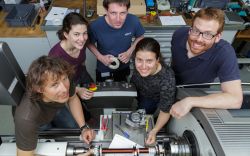
Collaborating with Markus Greiner’s research group from Harvard University, Francesca Ferlaino’s team of phyisicsts has been preparing for a set-up to carry out new experiments with ultracold erbium atoms. Engineers working at the IQOQI have also been part of the preparations.
In April, Anne Hèbert and Susannah Dickerson from Markus Greiner’s research group at Harvard University were visiting their peers at the Institute for Quantum Optics and Quantum Information (IQOQI) in Innsbruck. Together with Albert Frisch and Philipp Ilzhöfer, who work in Francesca Ferlaino’s research group, and engineers from IQOQI’s mechanical workshop, they built two so called Zeeman slowers. This scientific apparatus consists of an ultra-high vacuum cylinder and is used to slow down and cool atoms emitted from a high-temperature oven. In the experiment, the longitudinal velocity of the erbium atoms is reduced from the order of 370 m/s to 5 m/s. “This is done by the spreading of counter-propagating photons emitted from a resonant laser beam. In addition, we need a precisely defined magnetic field to keep the photons resonant to an atomic transition,” explains Albert Frisch. This magnetic field is produced by solenoid-like coils wound around the cylinder. The two Zeeman slowers will be used in new experiments with ultracold erbium atoms carried out in Innsbruck and at Harvard University.